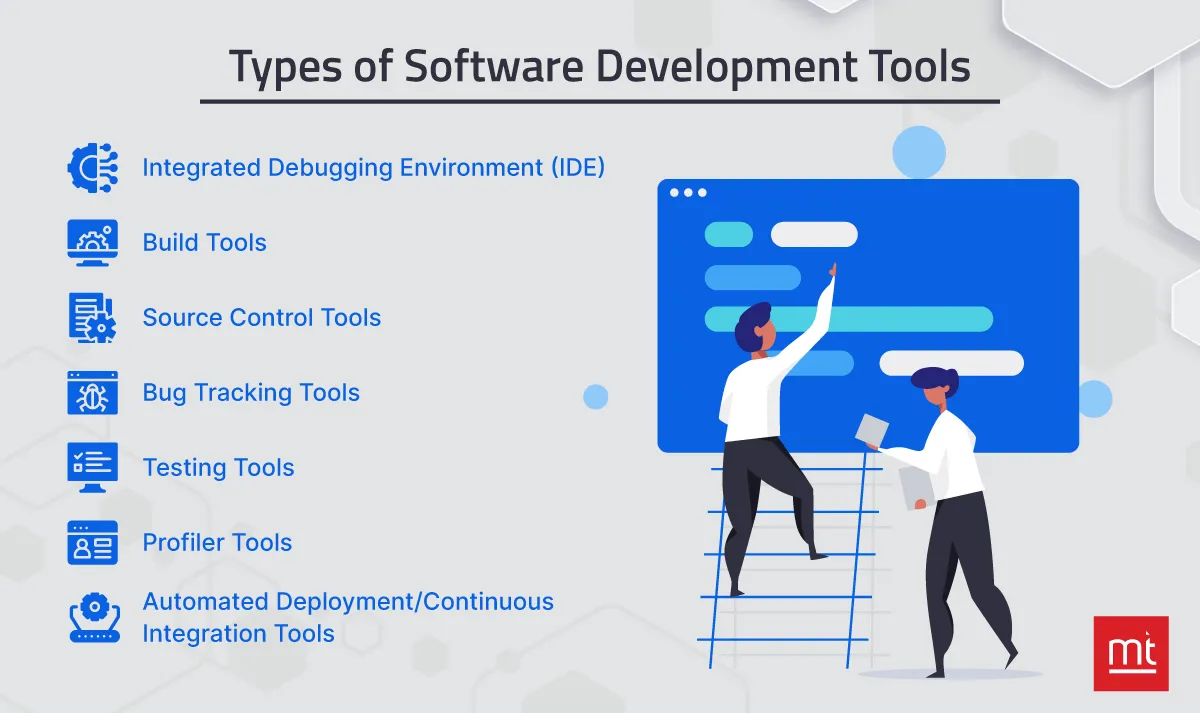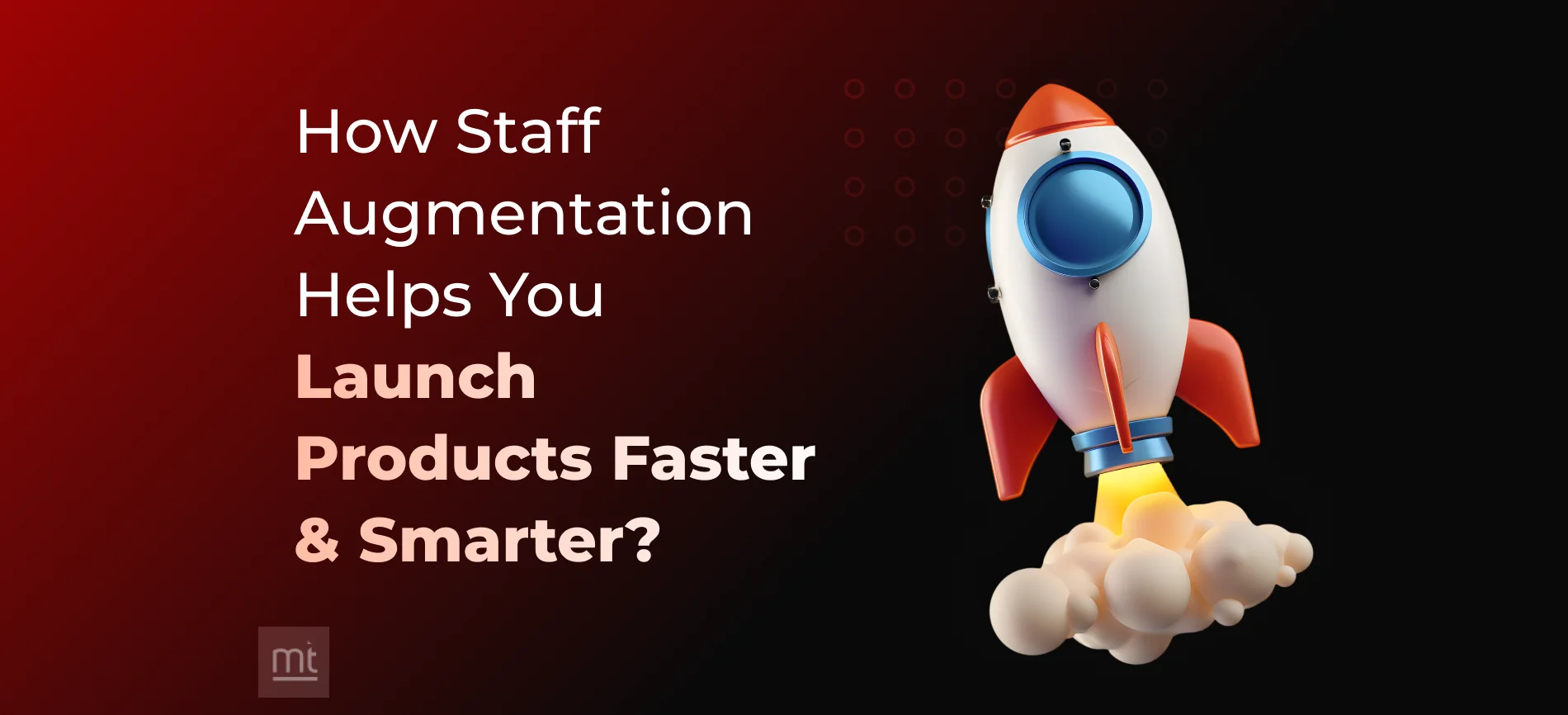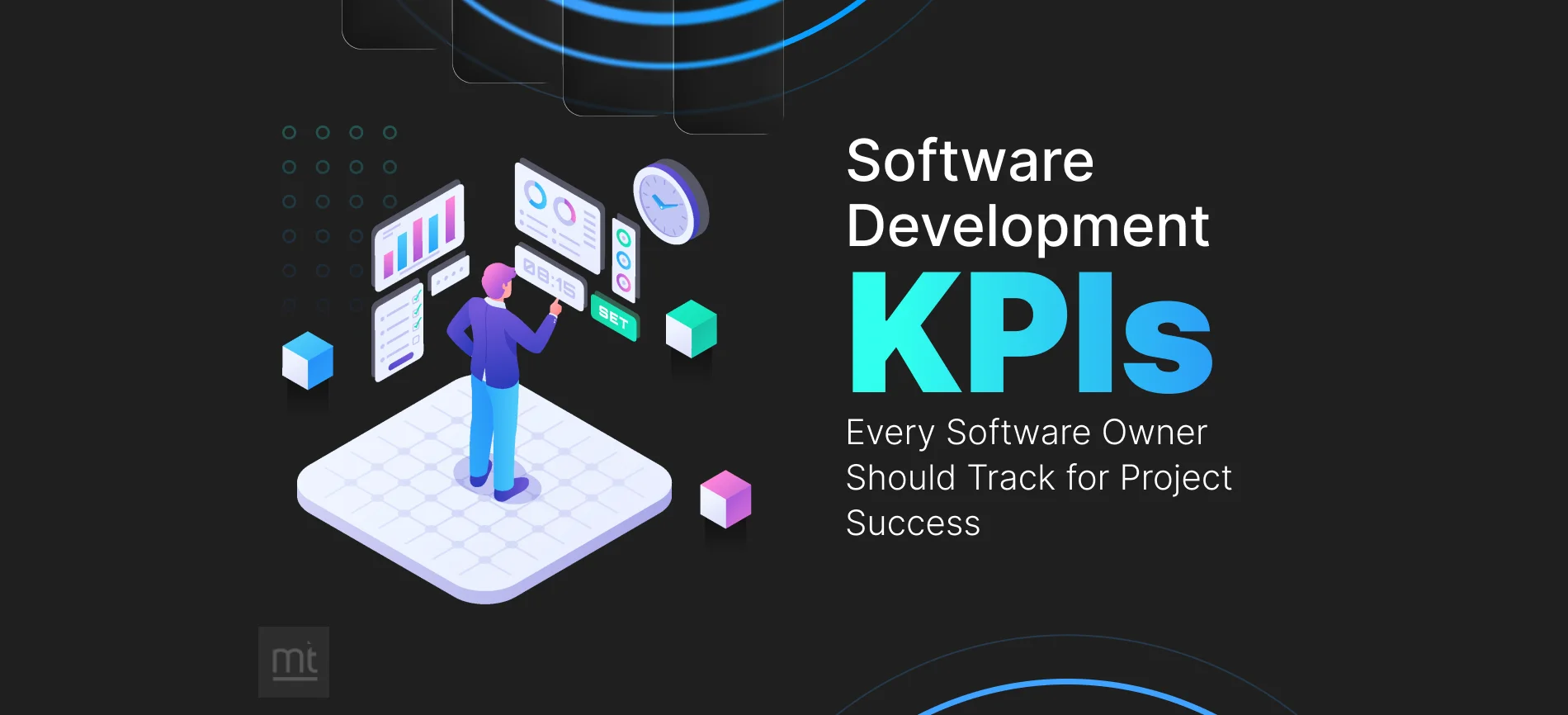Get Free Trial Week Developer Access, Try Before You Hire. Click Here to Claim Now
Software Development Tools: Have you ever imagined a day in a software developer’s life? Ask anyone, and you would probably get the same answer. They must have spent their entire day compiling and debugging the program. Most of the development team’s productive hours are wasted in running, compiling and assessing the programs.
They have limited to no time for other aspects, including innovation. As the software development landscape is evolving, it is attracting more competition, seeking high capabilities from developers.
If the market has to reach the estimated $858.1 billion by 2028, they must work on innovation and accelerated development. Software tools can empower your developers and facilitate them to offer incredible solutions.
From extending third-party libraries to offering diverse plugins/extensions, the software development tools will boost your development team’s efficiency and collaborative abilities.
In this article, we will walk you through the need for software development tools, their types and other aspects for a detailed understanding.
What Are Software Development Tools?
What comes to your mind when we say tools? Equipment that can make your work easy, we suppose. That’s exactly what you can achieve with software development tools.
They help develop solutions easy and effortless for the developers. They house a set of libraries, codebases, templates and other equipment to ensure smooth development. Their smart features allow your developers to put in less effort and grow the code faster.
As they are visionary in nature, you will get to enhance your collaborative abilities with these software development platforms.
Different Types of Software Development Tools
There are different software tools that help developers with specific solutions. They will be used across the software development lifecycle. We will introduce these tools in this section.
1. Integrated Debugging Environment (IDE)
Integrated Debugging Environment is an entire software suite that you can use for a range of software development activities- designing, coding, testing, debugging and deploying. You will have all the important tools within the IDE such as the code editor, compiler and debugger. As a result, you can conduct all the development tasks from your IDE.
2. Build Tools
If you want to use a single tool to build, customize and test your codebase, you should choose build tools. They can simplify the complex workflows and help you convert the code binaries that machines can easily interpret.
Moreover, these tools help establish consistency throughout your code, thus enabling better quality and decoding abilities.
3. Source Control Tools
Isn’t tracking source code changes an important part of maintaining the codebase? That can be tiresome and tedious if you don’t have tools supporting you. That’s why you must include source code tools in your infrastructure.
They would help you maintain the different source code versions, handle the central repository and ensure better accessibility.
4. Bug Tracking Tools
Have you been facing a lot of struggles trying to debug and test your software? Implementing the bug tracking tools is an excellent way to ensure a high-quality codebase. You can easily deploy code that adheres to the coding standards.
5. Testing Tools
If you want to test your solutions before deploying, building the test cases can take up maximum developer time. With testing tools, you can easily automate developing test cases. EVentually, you can plan effective testing solutions.
6. Profiler Tools
When you are interested in improving the performance of your software solution, you must invest in profiler tools. They can analyze the performance overhead and the bottlenecks with greater ease. You will get detailed insights into how you can enhance the app’s performance.
7. Automated Deployment/Continuous Integration Tools
Continuous integration and deployment can help accelerate the build-to-commit process, thus reducing launch time. You must invest in these tools as it allows the development, testing and deployment teams to work together. It will also help automate several build-to-test processes, thus increasing the developer’s productivity.
Factors to Consider Before Selecting a Software Development Tool
Did you see the diverse tools available within the software development landscape? Confused about which tool would help you accomplish your goals? We might be able to help you select the tools. Here are the top tips from our dedicated developers on how they select tools for any project.
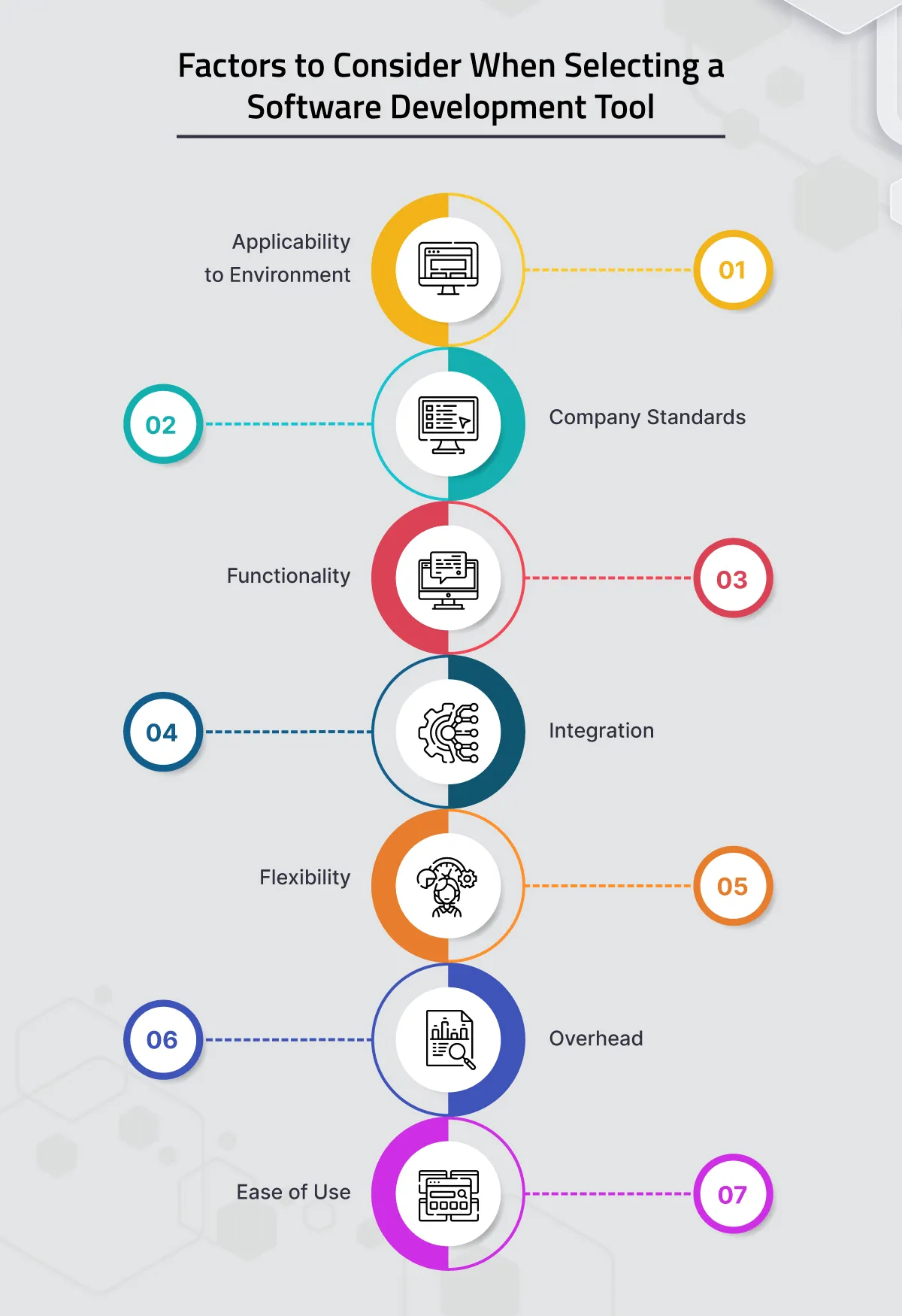
1. Applicability to Environment
Are you working with a particular programming language, a compiler and a framework? Does the particular tool support your development lineup?
When selecting the tool make sure it meets your software tech requirements. It must offer you all the libraries and extensions that can make app development hassle-free.
2. Company Standards
Have you defined the best practices for software development? Do you have a development guidelines document? When you decide on the software tool, you must ensure it can help you align the software to your best practices and coding standards. Moreover, it should be compatible with your custom workflows and deliver consistent solutions.
3. Functionality
When you are creating a software solution, you need to plan the features and functionality in advance. This will help you select the ideal tool for your project. You must ensure that the tools can offer the functionality or performance you desire.
Similarly, define the tools that extend a comprehensive feature set to improve the functionality and performance of the app.
4. Integration
When choosing the tool for your software solution, you must ensure that it integrates with the chosen development environment. At the same time, your tools should easily integrate with the Version Control Systems and Issue Tracking. This would boost the efficiency of your defined workflow.
5. Flexibility
The tool must be flexible for you to scale the project and improve the abilities of the software solution. It should easily fit the increasing project size, different team structures and distinct development methodologies. Your tool must accommodate the growing needs of your software solution.
Having a futuristic view can help you choose the perfect software for your business.
6. Overhead
When your tools take up a lot of memory and disk space, they cost you in terms of overhead. You will notice that tools that exceed the processing power usage can reduce your performance significantly. This overhead will automatically add to the cost of software development.
You can avoid this by choosing a tool that optimizes the overhead costs.
7. Ease of Use
The developers should find the tool easy to use and access. Choose a tool that is intuitive and can be easily learnt. The low learning curve with ease of adoption will help you plan and release software projects with greater ease.
Efficient tools can also increase the productivity of your system.
Software Development Tools To Increase Productivity in 2026
Are you planning a software solution that you want to launch to the market? Are you a development company that keeps abreast with the latest tools and technologies. In either case, this list might help you plan the appropriate tech stack for the projects.
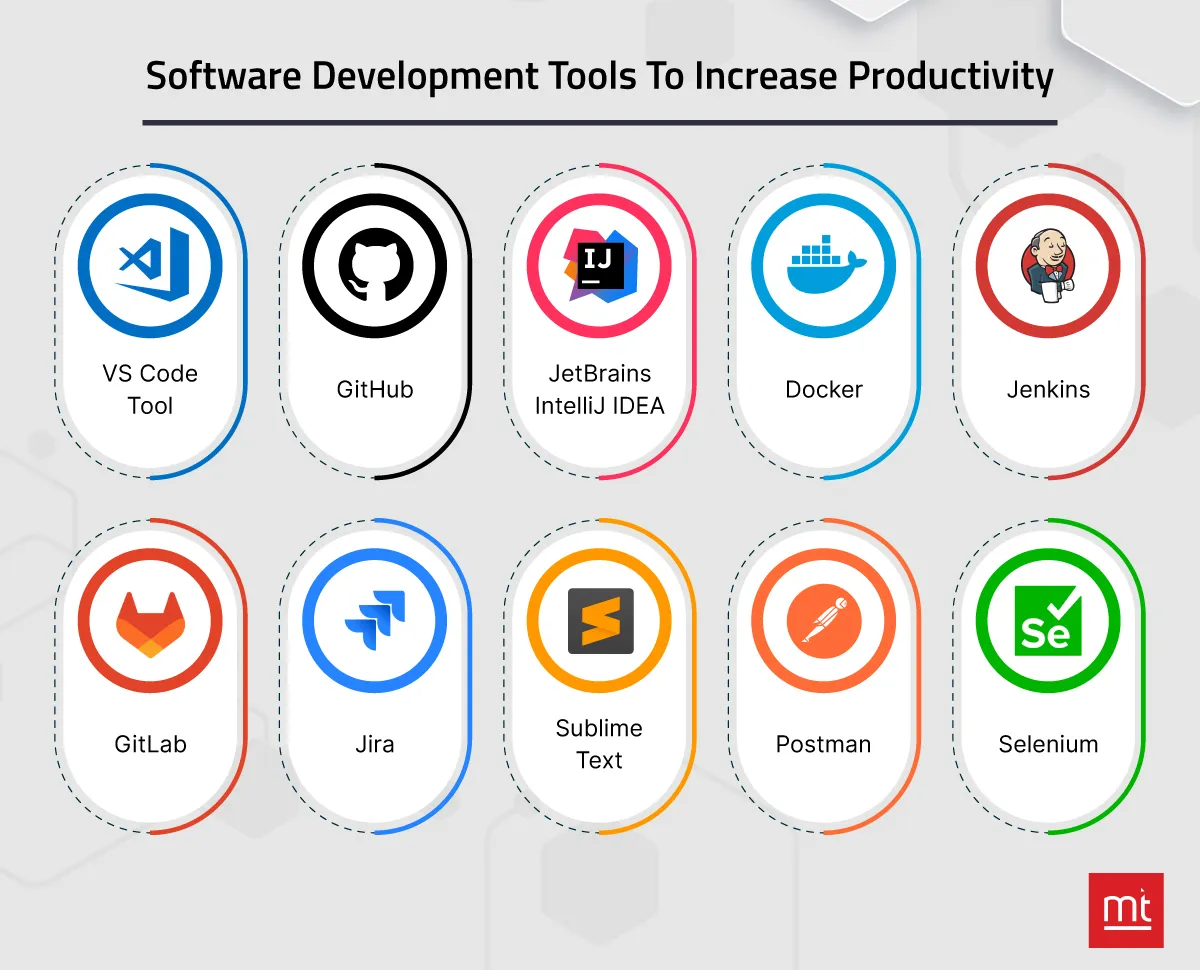
1. VS Code Tool
Microsoft reimagined the code editor space with Visual Studio Code tool. Your developers can create and test modern and cloud-based solutions using this tool. Majorly used to develop cross-platform applications, you can quickly simplify complex workflows. Additionally, it allows developers to reuse the components.
The best part being it is compatible with Windows, Mac and Linux.
The Key Features of VS Code Tool
- VSCode supports diverse programming languages including Swift,Java and others. As a result, you can easily use it to build a robust tech stack
- As it includes an intelligent completion feature, you can use it to increase developer’s productivity. They can use the suggested code to complete the syntax
- There are in-built debuggers that allow you to speed up quality assessments and develop clean code
- The live share allows your developers to collaborate in real-time to accelerate resolutions
Pros and Cons of VS Code Tool
Pros | Cons |
You can use it for all project types as it is lightweight and fast | As it is not a development environment, you may not have all the advanced development features |
You get an excellent community support | Your developers need to follow a slight learning curve before using the code editor. |
Customize all your solutions and build with greater ease | |
You can integrate it with any Version Control System |
Pricing
It is an open-source software development tool. As a result, you don’t need to pay any license or download fee.
Customer Ratings
Capterra | 4.8/5 |
G2 | 4.7/5 |
2. GitHub
As a web based tool, GitHub can easily help developers with version control and enabling project management. Your development team can use the platform as their central repository to store the projects, collaborate over changes and host the final version.
You can also access the open-source projects and code available to inspire your development.
The Key Features of GitHub
- Using Git’s version control system, your developers can track the source code changes
- You get a documented repository for your projects allowing easy access
- You can track and maintain the issues within code and ensure timely quality assessments
- Commenting is a great feature that allows you to enhance the testing abilities of your team
- Your team can access detailed suggestions from code reviews to help incorporate the apt resolutions
Pros and Cons of GitHub
Pros | Cons |
You can ensure strong version control strategies as it has a robust footing with Git | You don’t get access to advanced code editing features |
The user interface is friendly and interactive | For security reasons, you may prefer on-premise infrastructure for proprietary code |
GitHub extends a complete documentation, making it easier for you to build the application |
Pricing
You can choose from these plans
Free Plan: It is available without any fee
Team Plan: $4 per month
Enterprise Plans: custom pricing
Customer Ratings
Capterra | 4.8/5 |
G2 | 4.7/5 |
3. JetBrains IntelliJ IDEA
This is an integrated development environment developed by JetBrains, which offers you rich and usable features to build software solutions. It is an all-encompassing platform that helps you build the code, debug the application and test the solutions. It is backed by Java programming language, which allows developers to build apps swiftly.
The Key Features of JetBrains IntelliJ IDEA
- It offers intelligent code assistance, which makes code building, navigation and analysis swift for the developers
- You can access different refactoring tools to ensure high quality and easy to maintain codes
- It supports multiple programming languages, thus ensuring ease of programming
- You get step-by-step debugging ability with the in-built debugger. You can also analyze the performance with the in-built profiler
- It supports various plugins and extensions, which allows you to extend the app features to suit your needs
Pros and Cons of JetBrains IntelliJ IDEA
Pros | Cons |
It supports various programming languages and frameworks | It is not a lightweight code editor |
Supports intelligent code assistance for better code quality | You might need to undergo a learning curve |
Can be used for easy and complex projects |
Pricing
For Enterprises
- Ultimate: $599
- All Product Pack: $779
For Individuals
- Ultimate: $169
- All Product Pack: $289
Customer Ratings
Capterra | 4.7/5 |
G2 | 4.4/5 |
4. Docker
This is your open-source tool that extends containerization abilities to the developer. As the containers within the framework are lightweight and portable, you can easily create self-sufficient applications. you can also ensure consistent movement across the software solutions.
This tool also allows you to run applications using isolated containers, thus simplifying development processes.
The Key Features of Docker
- You can use this framework to package the applications and dependencies within containers to offer isolation
- You can pack the applications within docker images, which are shareable and easy to deploy
- There is a central repository for docker images, which makes the applications accessible and usable
- Containerization can be used to deploy the microservices application with greater ease
- You can isolate the resources into containers, thus restricting its access to applications
Pros and Cons of Docker
Pros | Cons |
It extends simple and consistent application development and dependency management | Overheads exist as it needs containerization |
You can create lightweight containers for efficiency | A steep learning curve when you need to develop complex applications. |
Offers a microservices architecture to support modern development practices |
Pricing
Personal: $0
Pro: $5 per month
Team: $9 per user per month
Business: $24 per user per month
Customer Ratings
Capterra | 4.6/5 |
G2 | 4.6/5 |
5. Jenkins
If you want an open-source and automation server that can help with CI/CD tasks, you must choose Jenkins. It can help automate and enhance the tasks related to development, testing and deployment. You can easily integrate code changes and increase the efficiency of your software development. Moreover, it is easy to integrate this tool with the different software development lifecycle stages.
The Key Features of Jenkins
- It helps automate code integration with multiple resources using a centralized repository
- You can also use this tool for continuous development and deployment of software solutions
- The plugin ecosystem allows you to extend the functionality of your development tool to encompass testing frameworks and more
- You can easily use distributed builds to make your developer’s life efficient and smart
- It offers in-built monitoring and reporting dashboards, giving a complete access into code analysis and insights
Pros and Cons of Jenkins
Pros | Cons |
It is an open-source and highly extensible platform | There is a slight learning curve to setting up and using the Jenkins tool |
You can use it to automate building and testing the development | You might need to maintain the platform for smooth performance. |
It is suited for developing all application types |
Pricing
It is a free software development tool. You don’t need to pay a licensing fee.
Customer Ratings
Capterra | 4.5/5 |
G2 | 4.4/5 |
6. GitLab
This is your web-based platform that comes with all the tools needed to build efficient software systems. You can use it to manage the source code, employ it for CI/CD and ensure regular monitoring. You get the ease of collaboration and extensive workflows using this tool.
The Key Features of GitLab
- You can use GitLab to manage and collaborate the source code via central repositories
- It comes with a CI/CD system that automates your software development lifecycle
- You can use the issue tracking and project management features to enhance the project planning
- You can track and manage the performance issues in your application
Pros and Cons of GitLab
Pros | Cons |
You get an entire range of tools needed to accomplish the software development lifecycle | If you incorporate the advanced features, you might experience a learning curve |
In-build CI/CD tools to improve the pipeline and security | It is not suited for smaller projects or teams |
It can commit to both cloud and self-hosted deployment solutions |
Pricing
Free: $0
Premium: $29 per user per month
Ultimate: $99 per user per month
Customer Ratings
Capterra | 4.6/5 |
G2 | 4.5/6 |
7. Jira
This is an Atlassian backed project management tool that is a must-have for your software development project. It can help you attain milestones, complete tasks on time and ensure greater agility. You can easily manage the errors and handle the compilation to deploy quality code with this tool.
The Key Features of Jira
- You can track issues, bugs and quality problems within the code and resolve them with tease
- The agile workflows enable iterative development, thus accelerating the coding time
- You can customize your workflows to suit your development requirements and enhance the solution
- There are several project management features that can enable better development processes
- You can integrate with a range of tools to extend your development capabilities
Pros and Cons of Jira
Pros | Cons |
It is versatile and widely used for a range of project management activities | It offers an overwhelming interface that can make development complex |
You an easily create different types of workflows with this tool | There is a steep learning curve involved for you |
It offers a comprehensive marketplace that helps you include different plugins and extensions to the software | You might find it slightly expensive |
Pricing
Free: $0
Standard: $7.75
Premium: $15.25
Enterprise: Custom
Customer Ratings
Capterra | 4.4/5 |
G2 | 4.3/5 |
8. Sublime Text
If you want to use a lightweight text editor to build and edit the code, you must include Sublime Text in your tech stack. It was developed to offer accessibility, usability and speed to the developers. Using this tool, your developers can easily create apps for a wide range of platforms and networks.
With the speed of development, you can launch your applications and gain more visibility.
The Key Features of Sublime Text
- You can edit multiple selections within the editor simultaneously thus ensuring perfection
- You can quickly navigate between the lines of code, and edit with fewer lines
- Split view of the panes allows you to simultaneously view two different files and check for issues
- You can use syntax highlighting to correct the code faster
- Auto-completion allows your developers to code with greater speed
Pros and Cons of Sublime Text
Pros | Cons |
You get excellent startup time with this tool | You will get fewer free updates. As a result, you need to upgrade to view an updated version |
You have an excellent ecosystem of plugins and extensions to improve the code’s functionality | The source code is not available; hence, you cannot customize it. |
The responsive community can help you whenever you are stuck |
Pricing
Paid: $99
Customer Ratings
Capterra | 4.7/5 |
G2 | 4.5/5 |
9. Postman
If you are looking for a collaborative tool that can help with development and deployment, choose Postman. It is available as a Chrome extension and helps developers build capable API solutions. You can use the desktop or web version of the app to build well-defined APIs for your software requirements.
The Key Features of Postman
- You can use the tool to automate API testing by building appropriate test cases
- You can use it to design and build APIs that suit the development needs
- It offers a feature that allows you to organize and group APIs that are similar for better execution
- You get complete documentation to enable better API development
Pros and Cons of Postman
Pros | Cons |
Comes with an intuitive interface that allows you to develop, test and launch APIs | It comes with a slight learning curve |
The automated testing framework offers powerful features to improve testing outcomes | You might have to pay for the advanced features. |
You can easily extend your API functionality with this tool via integrations and plugins. |
Pricing
Basic: $12 per user per month
Professional: $29 per user per month
Enterprise: Custom
Customer Ratings
Capterra | 4.5/5 |
G2 | 4.4/5 |
10. Selenium
You can use this open-source tool to help automate testing of the software applications. you can easily test across platforms and browsers, and check for issues. With this tool, your developers can easily get insights into coding issues and resolve them with greater ease.
The Key Features of Selenium
- You can use the tool to complete web testing of click buttons, forms and other elements
- You can easily use it for cross-browser testing with popular browsers
- This extends multi-language support for your application
- You can use it to integrate with TestNG and JUnit to optimize the CI/CD pipeline
Pros and Cons of Selenium
Pros | Cons |
It is an open source platform so you can use it for free | You will face issues setting it up and configuring the tool |
It offers extensibility and flexibility | You might experience maintenance overhead with this tool |
It has a excellent user base |
Customer Ratings
Capterra | 4.5/5 |
G2 | 4.4/5 |
Why Software Development Tools and Frameworks Matter?
Software development tools can assist your developer in a variety of functions. Here are a few reasons to invest in software development tools.
- Increases Efficiency: Your developers can easily build, test and deploy applications with greater speed. This is because of the pre-built code, templates and in-built libraries that you get with the software development tools
- Consistent Code: As you will be adhering to the business best practices and implementing the defined coding conventions, you will notice consistency throughout the codebase
- Automation: You can easily automate workflows and repetitive tasks using these tools. Moreover, you can even automate the build-to-test pipeline with CI/CD tools to enhance development processes
- Ease of Collaboration: Your development and testing teams can collaborate without being in the same room. They can maintain the agility of code development and enhance the deployment processes
- Cost Saving: As most of the tools are open-source in nature, you may not spend a lot of money on them. Moreover, you can get the software developed with minimal resources
Conclusion
Software development tools are essential to speed up the development and offer greater productivity. It can enhance the solutions and boost your software’s efficiency. There are tools for all aspects of the software development lifecycle.
These tools can automate testing, help with code quality and ensure you adhere to the coding best practices. Selecting the right tool for your tech stack is important. You might want to check the compatibility with requirements, developer’s accessibility and ease of use before finalizing the tool.
ManekTech is a leading software development company with extensive experience in working with diverse tools across niches. We have experts in different programming languages and development frameworks. You can connect with our team to hire resources that best fit your needs.
Subscribe to Our Newsletter!
Join us to stay updated with our latest blog updates, marketing tips, service tips, trends, news and announcements!

